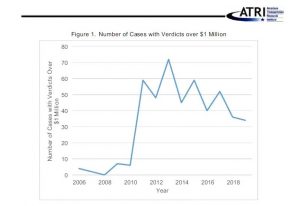Top 5 Dangerous US Highways
There are hundreds of television shows, movies, and songs that boast the life of truck drivers. These forms of entertainment always portray the freedom of the open road and just how cool it is to be a trucker. Jerry Reed made it look pretty fun in Smokey and the Bandit. His big smile, hearty laugh, and his best pal Fred made life on the open road look easy.
In 2007, America got an inside look at how dangerous truck driving is. Ice Road Truckers showed, for the first time, the grit and guts it takes to drive a big rig. The show follows truckers haul freight over frozen lakes where roads are unavailable. Viewers become entranced by the sound of popping ice and howling wind. You might even find yourself holding your breath as not to upset the ice on tv.
These are both unique examples of the trucking experience; one glamourous and one treacherous. The average trucker has never helped a fugitive with a carload of beer travel across the country, avoiding the police. Nor have they attempted to drive across a sheet of ice that waves and pops, threatening to swallow them up with one wrong move.
When your office is the interstate, and your coworkers are the general public, the job can be hazardous. According to the National Highway Traffic Safety Administration (NHTSA), truck driver fatalities increased 48% from 2009-2019.
Top 5 Dangerous US Highways for Truckers
Freight Waves recently released an infographic about the most dangerous highways for truck drivers, and the numbers are staggering. Between 2010 and 2016, there were 1,700 truck-related fatalities on just five highways in the U.S.:
5 – Oklahoma – State Route 9 with 17 deaths per 100 miles.
4 – Arizona – U.S. Highway 93 with 45 deaths per 100 miles.
3 – Colorado – U.S. Highway 160 with 20 deaths per 100 miles.
2 – Texas – Interstate 10 with 77 deaths per 100 miles.
1 – California – Interstate 5 with 96 deaths per 100 miles.
It is unclear if these highways have one major commonality that causes these accidents. Across these southern states, there are many variants to population, speed limit, weather, and altitude. What do you think of the top 5 dangerous US highways for truckers and do you think we are missing any?
Some may consider combining lengthy rural stretches that suddenly meet with big city traffic to be the main factor. Others view highway obsolescence to be a major cause. This is especially true through well-established cities. Over the years, highways have been re-routed, expanded, and manipulated to accommodate a growing population. Overcomplicated add-ons such as additional bridges, passes, and access roads can make these roads confusing. Navigating these built-up access points that weren’t planned initially can be difficult.
These five highways are major freight corridors, meaning truck drivers must travel these roads often. Below, you’ll find some of the most common situations that can lead to devastating accidents.
Top 5 Risky Situations for Truckers
Complacency (Road Blindness)
Road blindness is an interesting phenomenon in which a driver arrives safely but cannot recall the drive. You can easily forget to pay attention to your surroundings while driving, even for a short distance. Maybe a fantastic song comes on the radio, or you are deep in thought about something important. Or maybe you have driven a particular road hundreds of times. Your brain goes into a sort of auto-pilot, going through the motions but you are not actively present.
The danger arrives when something out of the ordinary happens. Let’s say you are about 10 miles from your nighttime parking spot. There’s no other traffic on the road, so you begin making a mental list of things you need to do after you park.
First, you’ll eat. Next, take a shower. Then head back to the truck, tidy up, watch a movie, and go to sleep. You’re deep in thought about how great it will feel to drift off to sleep when you’re driving through blown-out tire shreds on the highway. They didn’t just appear. But you were so entranced in thought; you didn’t even notice until it was too late.
Traffic
No one loves stop-and-go traffic, especially when you get paid by the mile. Traffic jams and congestion require every bit of a truck drivers’ attention. In addition to their rig, they must be aware of surrounding drivers.
Truckers have the upper hand in a traffic jam. The height of the cab allows them to see further and with more clarity than passenger cars. But they also have to pay attention to the cars behind them, making sure to give timely visual cues to following vehicles.
Always check the side view for lane changers and drivers cutting in front of others. The longer a traffic jam lasts, the more agitated other drivers become. A commuter driver who tries to “beat the traffic” at a standstill has little regard for the safety of others.
Construction
Construction zones are a nightmare for most drivers, especially truckers. It is challenging to navigate a 53-foot trailer through narrow lanes, flashing lights, bottlenecks, and stop-and-go traffic. Add to that the presence of construction workers performing tasks 10 feet from your rig as you drive. Then throw in a few rubberneck drivers, zippy lane changers, and texting drivers, and you have a recipe for disaster.
“Confusion, frustration, merging/distracted four-wheelers, speed limit changes, narrow lanes, and hundreds of attorneys are hoping you make a mistake. Work zones are dangerous; it’s that simple.”
Mark Rhea, Industry Expert and former president of Lisa Motor Lines
In 2019, work zone crashes accounted for 842 fatalities. Of those deaths, 34% were truck drivers. The most common causes of work zone crashes are improper following distance, distraction, failure to “lean and look,” speeding, and ignoring blind spots.
In April, we hosted Maria Robertson of ATSSA and Dan O’Brien of Fundamental Underwriters to discuss the danger of construction areas. For more information about National Work zone Awareness Week, check out our webinar here.
Fatigue
Drowsy driving can be as dangerous as drunk driving when comparing how each affects the driver. Driving while fatigued can lessen your ability to pay attention, slow down reactions, and make it hard to make quick decisions.
According to the CDC, commercial drivers are more likely to drive tired. The number one thing a truck driver can do to prevent fatigue is planned every day. Find a parking spot as part of your trip plan. You can use services like truckpark.com to reserve safe and secure parking spots.
Most people know when and where they will fall asleep for the night. They can make adjustments in their schedule to allow for more rest if necessary. Truckers do not have that luxury. Read more about truck parking nightmares here.
Impairment/Distraction
Every drunk driver holds a higher potential to cause accidents, injuries, and death. Driving an 80,000 semi-truck while intoxicated, however, is far worse. Drunk truck drivers disregard company policies, the law, their safety, and the general public’s wellbeing. Operating a tractor-trailer without a sober mind can lead to mayhem and destruction due to the tractor-trailer’s size, weight, and velocity.
A big truck accident involving a drunk trucker is fodder for billboard attorneys. Trucking accidents influenced by alcohol or drugs are almost a guaranteed win for prosecutors. Minimizing the impact of impaired accidents begins with the hiring process. Most drunk drivers who were killed in an accident are repeat offenders. According to NHSTA, drivers involved in fatal accidents are four times more likely to have already been convicted of drinking and driving.
Top 5 Things That Keep Truckers Safe
Infinit-I is one of the trucking industry’s most powerful tools to prepare truck drivers for the dangers of highway travel. If your goal is empowering your fleet to become the safest and most efficient fleet, Infinit-I has all the tools to make it happen. We offer industry-specific training to prepare your drivers specifically for the safe operation, including:
Route Management: This video goes over scenarios drivers find themselves in when delivering a load. It discusses proper pre-trip planning, determining the best highways, jotting down notes to refer to while driving, and GPS mistakes. It also discusses taking breaks, rush-hour traffic, fuel stops, route management issues, and communication with the dispatcher and the customer.
Distracted Driving Awareness – Hands-Free Device Allowed – Mobile phone usage in CMVs is a hot topic for drivers and carriers because of the dangers they create. It’s essential for drivers to know their company’s policy on this topic and follow the rules carefully. In this video, learn the laws, what is considered distracted driving, the definition of mobile phone usage, associated risks, how to comply with the rules, and proper utilization of hands-free devices while operating a CMV.
Intersections: Expect the Unexpected – Intersections are dangerous places. Drivers pass through many intersections each day and may not be as alert as they should be. As professionals, drivers are responsible for their safety and the safety of others on the road. This video reviews how to safely negotiate intersections.
7 Deadly Errors Cars Make Around Large Vehicles – One fundamental way to improve your skills as a defensive driver is to anticipate the mistakes other drivers will make around you. This video discusses the seven deadly errors small vehicles make around commercial motor vehicles (CMVs) and gives defensive driving tips for CMV drivers.
Under Construction: Trucking In Work Zones
- When driving through work zones, drivers should remember that special caution is needed to avoid preventable accidents. This video discusses how road conditions, time of day, and lighting contribute to unique problems that can cause accidents in work zones.
- As drivers pass through potentially hazardous work zones, it is crucial they use caution to avoid preventable accidents. This video discusses the importance of maintaining proper speed, avoiding convoying, and expecting the unexpected.
Download the Infinit-I Workforce Solutions Training Catalog here to see our 850+ video library.
Infinit-I hopes that you learned something from our Top 5 Dangerous US Highways article and please feel free to read more about the top concerns in 2021 which is Truckers Parking Nightmare article.
Please check your trucking route and plan accordingly when you venture onto the Top 5 Dangerous US Highways on your next trip.








 Your frequency, consistency, and focus on safety training will prove your commitment to safety. Enhance your safety culture now and positively change driver behaviors before you are faced with legal trouble. Not only will you proactively protect your company from nuclear verdicts, you will be protecting your drivers from injury or death.
Your frequency, consistency, and focus on safety training will prove your commitment to safety. Enhance your safety culture now and positively change driver behaviors before you are faced with legal trouble. Not only will you proactively protect your company from nuclear verdicts, you will be protecting your drivers from injury or death.


 Truckers do a tough job, and many times, they don’t even receive recognition for it. They stay on the road sometimes for weeks or even months at a time away from family. Truckers work for up to 11 hours per day, day in and day out. This takes its toll, and we have to recognize the sacrifice that truckers make every day helping to keep the American economy in blossom. We have to salute those on the frontlines because, without them, our way of life would change greatly.
Truckers do a tough job, and many times, they don’t even receive recognition for it. They stay on the road sometimes for weeks or even months at a time away from family. Truckers work for up to 11 hours per day, day in and day out. This takes its toll, and we have to recognize the sacrifice that truckers make every day helping to keep the American economy in blossom. We have to salute those on the frontlines because, without them, our way of life would change greatly.


 work at their own pace while online, they get to spend more time with their family. This means, when your drivers do show up for their truck assignment, they aren’t worn out by several days of repetitive workshops or classes. They are fresh; ready to hit the road and make some money.
work at their own pace while online, they get to spend more time with their family. This means, when your drivers do show up for their truck assignment, they aren’t worn out by several days of repetitive workshops or classes. They are fresh; ready to hit the road and make some money. Our safety program has proven to decrease our client turnover by up to 53%. That means is possible for Infinit-I Workforce Solutions to take you from 100% turnover to just 47%. A reduction in turnover like that would save you over half a million dollars per year in onboarding costs. Incredible!
Our safety program has proven to decrease our client turnover by up to 53%. That means is possible for Infinit-I Workforce Solutions to take you from 100% turnover to just 47%. A reduction in turnover like that would save you over half a million dollars per year in onboarding costs. Incredible!



 They experienced numerous infrastructural challenges along the way. The convoy damaged bridges, became stuck off-road, and damaged equipment as a result of roadway conditions. The trip across the country took two months.
They experienced numerous infrastructural challenges along the way. The convoy damaged bridges, became stuck off-road, and damaged equipment as a result of roadway conditions. The trip across the country took two months.



















